This is the website of Abulsme Noibatno Itramne (also known as Sam Minter).
Posts here are rare these days. For current stuff, follow me on Mastodon
|
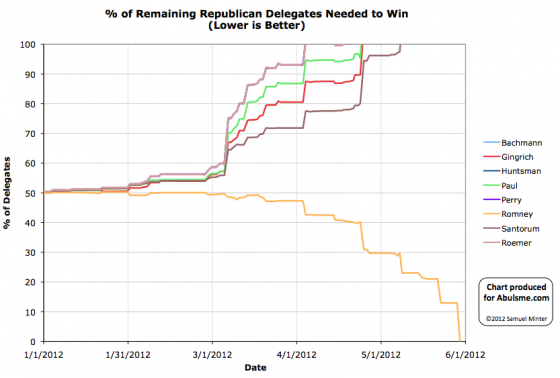
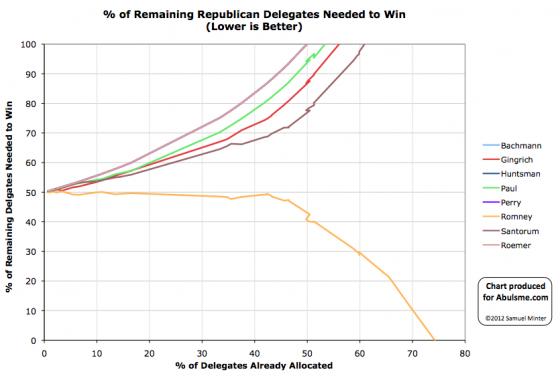
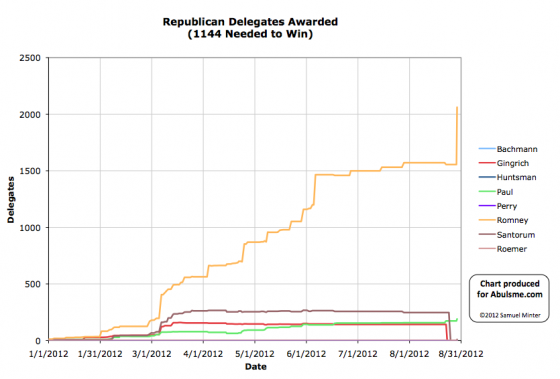
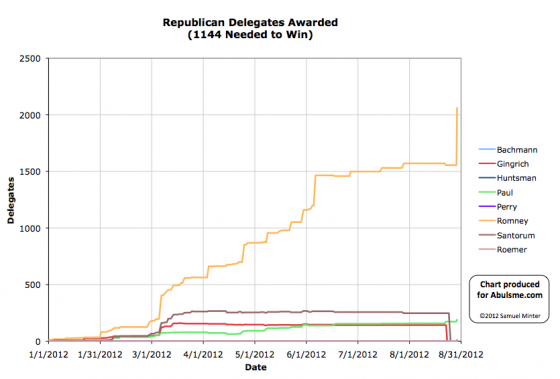
While there are still speeches yet to come, and a few more things my happen at the Republican National Convention, the actual nomination is now complete. The Republicans officially have a nominee. So time to review the final results of the delegate race.
| Stage |
Bachma. |
Gingri. |
Huntsm. |
Paul |
Perry |
Romney |
Santor. |
Roemer |
NV/U |
| Peak |
2 |
159 |
2 |
173 |
6 |
1571 |
268 |
0 |
|
| Final Est |
1 |
142 |
0 |
173 |
0 |
1555 |
247 |
0 |
168 |
| Roll Call |
1 |
0 |
1 |
190 |
0 |
2061 |
9 |
1 |
23 |
| Official |
0 |
0 |
0 |
0 |
0 |
2061 |
0 |
0 |
255 |
Peak represents the highest delegate estimate the candidate had during the primary season (not counting the final convention results).
The final estimates reflect the best estimates used here as of the “end” of the primary season. Specifically these is the estimate on August 22nd 2012, right before Gingrich and Santorum released their delegates. These released delegates were then free to vote for whoever they wanted in the Roll Call.
The roll call represents the count of the votes verbally given by the states at the Roll Call at the convention on August 28th 2012. (There were five votes in Pennsylvania that some reported as going to Paul Ryan, others have said the speaker said “Paul, Ron”. I believe these were intended for Ron Paul, so have counted them as such.)
The official count represents the vote as recorded by the convention. Romney was the only candidate who was officially nominated and seconded at the convention, so therefore was the only candidate who could officially receive votes and have them registered. Officially any votes for anybody else were equivalent to abstentions.
Lots more details on the final results of the full process can be found on the Results of the 2012 Republican Party presidential primaries page on Wikipedia, Green Papers (including totals), and DCW.
Note: Charts from the Abulsme.com 2012 Republican Delegate Count Graphs page. The first and second charts represent the % of remaining delegates the candidates needed in order to reach 1144 and win the nomination. Going above 100% represented being mathematically eliminated, dropping to 0% represented “clinching” the nomination. The first chart shows this by date, while the second shows this by % of the delegates determined so far. The third chart is the % of delegates the candidate has collected. The fourth is the actual number of delegates. These numbers include estimates of the eventual results of multi-stage caucus processes as those estimates were refined over time. The final data point represents the roll call count, not the official results which only counted votes for Romney.
[Edit 2012 Aug 29 14:59 to add two more charts and revise the final note.]
[Edit 2012 Aug 29 15:42 to add links to sources for more info.]
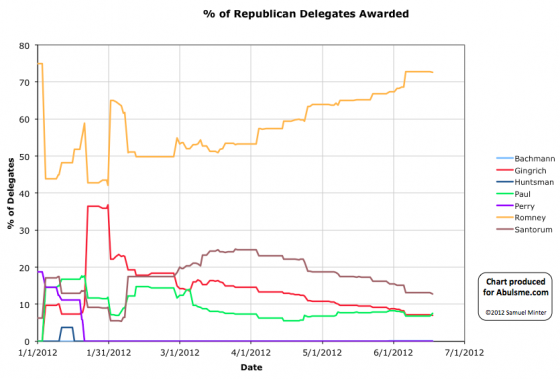
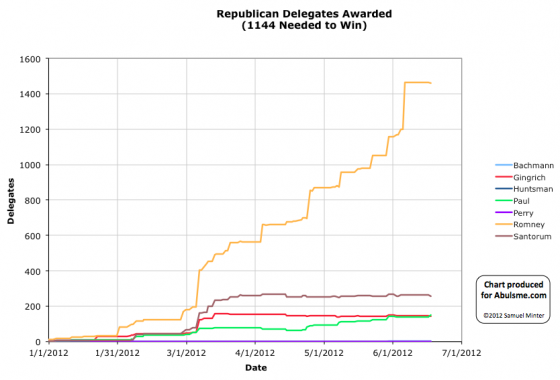
Charts from the Abulsme.com 2012 Republican Delegate Count Graphs page. The first chart is the % of delegates the candidate has collected, the second is the number of delegates. These numbers include estimates of the eventual results of multi-stage caucus processes which will be refined as the later stages occur.
Not that it matters at this point, but as the final results from Iowa came in this weekend, the results for Ron Paul were more favorable than the original estimates, so he gained delegates in my count, and the others lost delegates. The result is that Ron Paul has now passed Newt Gingrich for third place. (I use the Green Papers Soft Count, plus the DCW super delegate count in places where Green Papers hasn’t included them).
This of course doesn’t change the end results here at all. Romney is the nominee. It does however show once again how the final results in caucus states can be dramatically different from the “estimated” results based on the popular vote in caucus states. In the case of Iowa, the initial estimate was Romney 6, Santorum 6, Paul 6, Gingrich 4. As of right now we have Paul 21, TBD 7. Quite a bit different.
There are a lot of people who argue that because of these sorts of things, one should only look at the “hard” count of delegates actually already fully allocated and bound rather than trying to estimate caucus states at all in the early stages or the way some officially uncommitted delegates will go. I still think there is some value in doing those estimates, but one must be very aware of the limits of those estimates.
For reference, my current overall count is this:
Romney 1459, Santorum 257, Paul 152, Gingrich 142, Bachmann 1, TBD 275
Green Papers “Hard” Count has the following:
Romney 1329, Santorum 251, Gingrich 143, Paul 98, Huntsman 2, Bachmann 1, TBD 462
A little different. Either way though, Romney wins. :-)
Update 2012 Jun 17 23:36 UTC: Made my format for delegate counts consistant.
Update 2012 Jun 18 18:38 UTC: Minor wording fix.
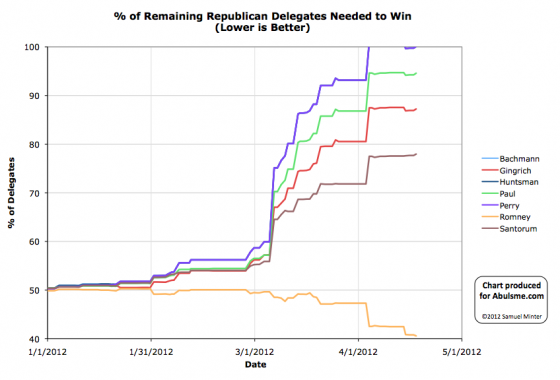
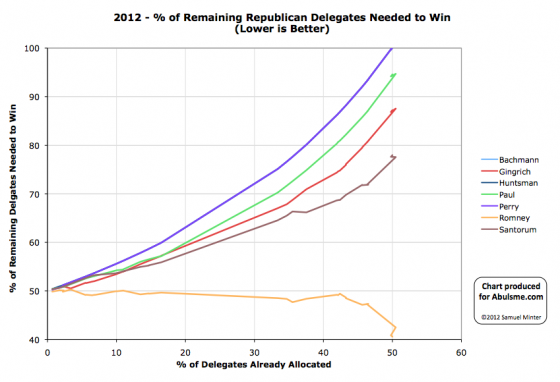
Charts from the Abulsme.com 2012 Republican Delegate Count Graphs page. When a candidate gets down to 0%, they have clinched the nomination. If they get above 100%, they have been mathematically eliminated. The first chart is by date, the second is by “% of Delegates Already Allocated”. These numbers include estimates of the eventual results of multi-stage caucus processes which will be refined as the later stages occur.
Over the last week DCW counted four new Romney superdelegates. Two from New York, one from Colorado, and one from Connecticut.
Four delegates is of course minor at this point and everybody knows the nominee is Romney, but we will continue posting updates until Romney actually gets to 1144. By the estimates I am using, he now has 680.
In terms of “% of remaining needed to win” this update gives us:
- Romney: 40.8% -> 40.6%
- Santorum: 77.7% -> 78.0%
- Gingrich: 86.9% -> 87.2%
- Paul: 94.2% -> 94.6%
This also puts us once again above 50% of the total delegates, which means anybody with no delegates at all is now once again eliminated absent the four candidates above losing delegates from their estimated totals (which can of course happen in various ways). So Bachman, Huntsman and Perrry… sorry about that.
The rest of this post is a note for anybody interested in the nitty gritty details of how I come up with my counts. Everybody else can stop reading now. :-)
When I started producing these charts in January I used Green Papers as my only delegate count source (specifically the soft count).
Very soon after that I realized Green Papers wasn’t including super delegate endorsements, so I started adding in the superdelegate counts from DCW.
Then a bit later on Green Papers started folding in the DCW numbers themselves, so I stopped separately adding them, and just used Green Papers count directly again. Sometimes there would be a day or two delay between DCW adding a Superdelegate and Green Papers incorporating that new information, but that wasn’t too bad.
It seems like Green Papers is getting a bit further behind now though. As of this post they hadn’t yet added the superdelegates DCW added on the 11th, 12th and 16th. So I figure until they catch up, I’ll manually add the DCW numbers again. This update catches us up to DCW’s super delegate count and puts the Romney numbers here slightly ahead of what Green Papers is currently showing.
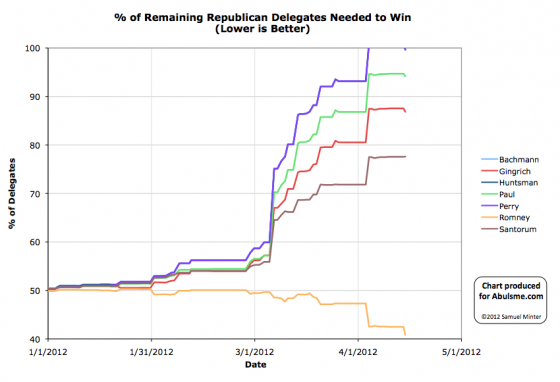
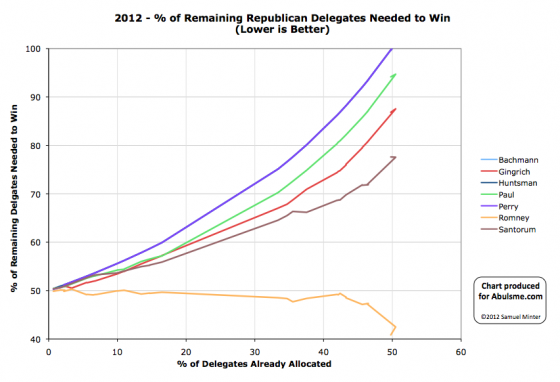
Charts from the Abulsme.com 2012 Republican Delegate Count Graphs page. When a candidate gets down to 0%, they have clinched the nomination. If they get above 100%, they have been mathematically eliminated. The first chart is by date, the second is by “% of Delegates Already Allocated”. These numbers include estimates of the eventual results of multi-stage caucus processes which will be refined as the later stages occur.
Wyoming and Colorado both have caucus type delegate allocation systems, where local caucuses earlier in the year are actually just the start of multi-month multi-stage processes. Both Colorado and Wyoming had their state conventions this weekend finishing off the delegate selection in those states.
Compared to the earlier estimates based on caucus results, the non-Romneys got crushed. Romney gained delegates. Everybody else lost delegates.
This is not surprising. It is common for the “clear winner” to end up taking far more delegates in the end than it looked like they would given the “straw poll” results at the first stage.
Looking more specifically…
- Colorado: The estimates after the caucuses were Santorum 13, Romney 12, Gingrich 4, Paul 4, and 3 uncommitted. This now becomes Romney 13, Santorum 6, and 17 uncommitted. All 36 delegates from Colorado are officially uncommitted, but using the current stated preferences of the delegates we have a net today from Colorado of Romney +1, Gingrich -4, Paul -4, Santorum -7.
- Wyoming: The estimates after the caucuses were Romney 11, Santorum 8, Paul 6, Gingrich 2, and 2 uncommitted. This now becomes Romney 22, Santorum 2, Paul 1, and 4 uncommitted. In Wyoming the delegates are bound. The net for the day in Wyoming is Romney +11, Gingrich -2, Paul -5, Santorum -6
Totaling the day we have Romney +12, Gingrich -6, Paul -9, Santorum -13. This does not look like a good day for the non-Romneys. Especially for Santorum. I guess dropping out of the race doesn’t help one’s ability to compete for delegates.
Notice though that we actually lost 16 delegates from the totals as some delegates that were predicted to go for specific candidates ended up uncommitted to any candidate. This actually increases the pool of potentially available delegates. In theory this improves the situation slightly for Gingrich and Paul, because, hey, they might still convince those uncommitted delegates to vote for them. (And indeed, some reports say many of those uncommitted delegates aren’t ready to support anybody else yet, but are not for Romney at this point either.) Santorum lost enough delegates that his situation actually gets worse anyway.
In terms of “% of remaining delegates needed to win”:
- Romney: 42.49% -> 40.85%
- Santorum: 77.56% -> 77.61%
- Gingrich: 87.54% -> 86.85%
- Paul: 94.70% -> 94.16%
I should also mention, that having these additional 16 delegates not committed brings the total number of delegates allocated by the estimates we use (the Green Papers soft count) back under 50% of the total number of delegates. Which actually means that the candidates with no delegates right now (Bachman, Huntsman, Perry, random others) are now no longer mathematically eliminated, and could catch up and win by capturing 99.65% of the remaining delegates. If they were actually on the ballot on all of the remaining states. Which they are not. :-)
So, uh, anyway… Romney still wins.
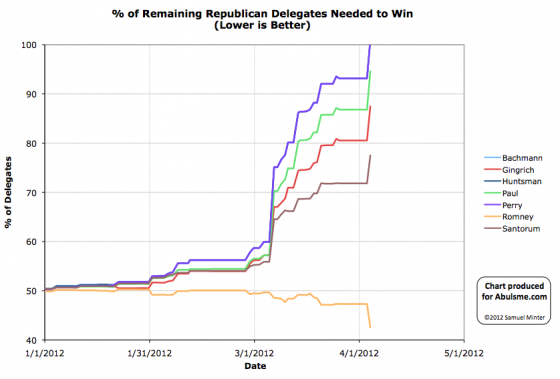
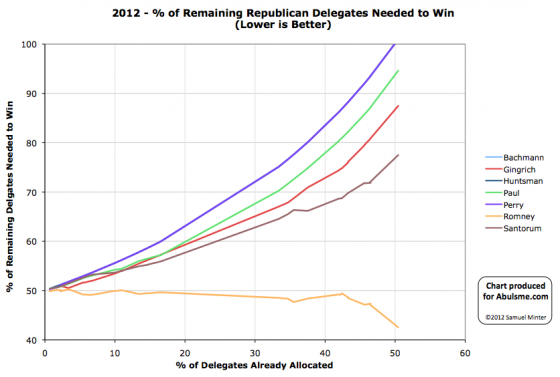
Charts from the Abulsme.com 2012 Republican Delegate Count Graphs page. When a candidate gets down to 0%, they have cinched the nomination. If they get up past 100%, they have been mathematically eliminated. The first chart is by date, the second is by “% of Delegates Already Allocated”. These numbers include estimates of the eventual results of multi-stage caucus processes which will be refined as the later stages occur.
So… this is it. Long ago any realistic possibility for any non-Romney to win the nomination disappeared. With today’s update the already long odds for the non-Romneys to keep Romney from getting to 1144 essentially drop to zero. This is over. Romney wins. Without any sort of brokered convention. For something else to happen now we’d need some event that was so earth shaking that Romney dropped out. This is extremely unlikely.
Details below.
We have updates from four contests. In alphabetical order:
- DC: DC is winner take all, Romney gets all 16 delegates.
- Maryland: Maryland is not actually winner take all, you get some delegates for winning the state, and then more delegates go to the winner of each congressional district. But Romney not only won the state, but every congressional district. So Romney gets all 37 delegates.
- North Dakota: North Dakota had the first round of its process in March. At that time the delegate estimate was Santorum 11, Paul 8 , Romney 7 , Gingrich 2. But the state Republican Convention happened last weekend, and Romney supporters owned the parliamentary process, taking the lion’s share of the delegates despite coming in third in March. That’s how it works in caucus states sometimes. It took a couple days for Green Papers to confirm a new estimate, but it now looks like Romney 20, Santorum 6, Paul 2. So the net today is Romney +13, Gingrich -2, Santorum -5, Paul -6.
- Wisconsin: Wisconsin also allocates some delegates based on both state and CD winners. Romney won the state. Romney won 5 CDs. Santorum won 3 CDs. So overall we have a delegate count of Romney 33, Santorum 9
Add those up and we have a net total for today of Romney +99, Santorum +4, Gingrich -2, Paul -6 Obviously Romney completely dominated the day.
In terms of “% of remaining delegates needed to win” we have this:
- Romney: 47.3% -> 42.5%
- Santorum: 71.8% -> 77.5%
- Gingrich: 80.5% -> 87.5%
- Paul: 86.8% -> 94.6%
The also-rans who left the race early on… Bachman, Huntsman and Perry… are mathematically eliminated after today. Paul, Gingrich and Santorum will inevitably join them soon.
The blocking Romney option? At this point the non-Romneys collectively would need to get 57.5% of the remaining delegates. So far they have managed 42.6% of the delegates. A change of this sort, while not mathematically impossible, would be unprecedented, especially since we are in the phase of the campaign where it is clear Romney is winning and the others are losing. People just stop voting for losers. As things go on, the % of delegates the non-Romneys get will probably actually decline. A major increase is just not going to happen.
It is over.
(We will of course continue to update these charts until Romney actually gets to 1144 however.)
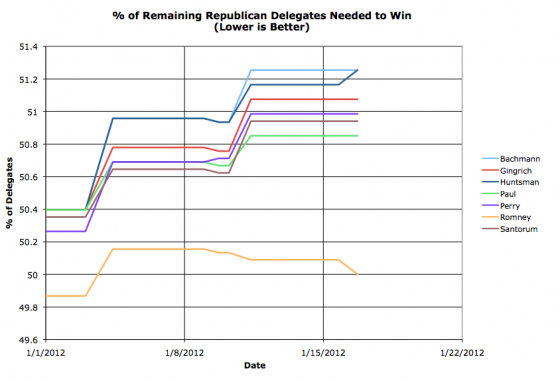
Nominally when a candidate drops out their delegates become free agents, but in practice if a candidate endorses another candidate, the delegates fall in line and vote for the person their candidate endorsed, at least for delegates from the primary and caucus process. My source for these delegates, The Green Papers, uses that presumption for their “soft count” (which is what I am using), so today we have Huntsman’s two delegates jumping over to Romney.
This also puts Romney back in the best position he has been in before voting started. He now has more than 50% of the delegates so far, which means he needs less than 50% of the remaining delegates to win. Another way to put that is that he doesn’t even have to match his performance so far to win. For the rest of the race he can do WORSE than he has done so far (including superdelegates!) and he will still win. The other candidates have to IMPROVE their performance in order to catch up and win. The amount they have to improve by isn’t completely out of the realm of contemplation yet, but it is getting higher.
|
|












